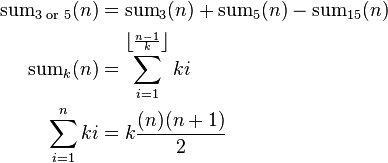Project Euler
| Project Euler | |
|---|---|
 | |
| Web address | projecteuler.net |
| Commercial? | No |
Type of site | Problem Solving Website |
| Registration | Free |
| Created by | Colin Hughes (aka euler) |
| Launched | October 5, 2001 |
Alexa rank |
|
Project Euler (named after Leonhard Euler) is a website dedicated to a series of computational problems intended to be solved with computer programs. The project attracts adults and students interested in mathematics and computer programming. Since its creation in 2001 by Colin Hughes, Project Euler has gained notability and popularity worldwide.[2] It includes over 500 problems,[3] with a new one added every weekend (except during the summer). Problems are of varying difficulty but each is solvable in less than a minute using an efficient algorithm on a modestly powered computer. Problems can be sorted on difficulty. A forum specific to each question may be viewed after the user has correctly answered the given question.[4] As of April 2015 Project Euler has about 475,000 users from all over the world (who solved at least one problem).[5]
Participants can track their progress through achievement levels based on the number of problems solved. A new level is reached for every 25 problems solved. Special awards exist for solving special combinations of problems, for instance there is an award for solving fifty prime numbered problems. A special Eulerians level exists to track achievement based on the fastest fifty solvers of recent problems so that newer members can compete without solving older problems.[6]
A subset of the Project Euler problems was used in an APL programming contest.[7]
There are 82 sequences[8] in the On-Line Encyclopedia of Integer Sequences (OEIS) referencing Project Euler problems.
Example problem and solutions
The first Project Euler problem is
If we list all the natural numbers below 10 that are multiples of 3 or 5, we get 3, 5, 6 and 9. The sum of these multiples is 23.Find the sum of all the multiples of 3 or 5 below 1000.[note 1]
Though this problem is much simpler than the typical problem, it serves to illustrate the potential difference that an efficient algorithm makes. The brute-force algorithm examines every natural number less than 1000 and keeps a running sum of those meeting the criteria. This method is simple to implement, as shown by the following pseudocode:
Set TOTAL to 0;
for every number NUM from 1 to 999 do
if NUM mod 3 = 0 or if NUM mod 5 = 0 then
add NUM to TOTAL;
output TOTAL
For harder problems, it becomes increasingly important to find an efficient algorithm. For this problem, we can reduce 1000 operations to a handful by using the inclusion-exclusion principle and a closed form summation formula.
Here,  denotes the sum of multiples of
denotes the sum of multiples of  below
below  .
In Big O notation, the brute-force algorithm is O(n) and the efficient algorithm is O(1) (assuming constant time arithmetic operations).
.
In Big O notation, the brute-force algorithm is O(n) and the efficient algorithm is O(1) (assuming constant time arithmetic operations).
Notes
- ↑ This is the inclusive OR, not the exclusive OR
See also
References
- ↑ "projecteuler.net site info". Alexa. Retrieved 26 June 2014.
- ↑ James Somers (June 2011). "How I Failed, Failed, and Finally Succeeded at Learning How to Code - Technology". The Atlantic. Retrieved 2013-12-14.
- ↑ "Project Euler (list of problems)". Retrieved 2015-02-01.
- ↑ "Project Euler - About". Retrieved 2008-04-04.
- ↑ "Project Euler (Statistics) - not accessible for anonymous users". Retrieved 2014-04-01.
- ↑ "Project Euler (News Archives)". Retrieved 2015-03-31.
- ↑ "APL programming contest problem list". Retrieved 2014-08-17.
- ↑ "OEIS sequences referencing Project Euler problems". Retrieved 2011-04-15.
